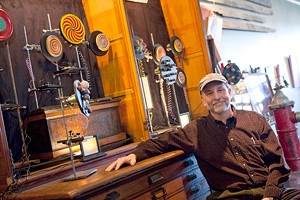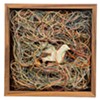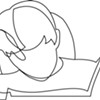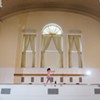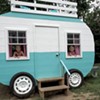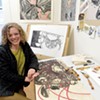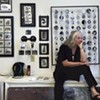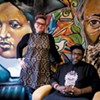Published April 20, 2011 at 5:53 a.m.
Peter Thomashow fishes through a box of Styrofoam peanuts for the various components of his “Origin of Life” sculpture. One by one, he pulls out glass beakers and test tubes, filled with “molecules” constructed of brightly colored wooden balls, and lays them on the carpet. He pauses for a second, and a smile spreads over his face. “This is good,” he says, “because we’re sitting on the floor on a Saturday morning.”
Most of a recent visit to Thomashow’s central Vermont studio is spent this way: sitting cross-legged on the floor, playing with toys. Around lunchtime, he offers home-baked English-muffin pizzas, and he sends his visitor home with her very own battery-operated, blinking-light art toy. It’s not your typical visit with a psychiatrist.
Thomashow, 57, is an artist, too — and a musician (he plays guitar and sings in a band); a collector (everything from magnets to turn-of-the-century factory workers’ badges); and a teacher (he’s on the faculty at Dartmouth Medical School). His art is a convergence of all these things. “Art and science,” he says. “I see them as identical modes of inquiry.”
For the last six years, Thomashow has been collecting antique toys, which he arranges in shadow boxes and cabinets and assembles to make what he calls “Toys From a Parallel Universe.” Earlier this month at the Main Street Museum in White River Junction, he unveiled his “Rotating Optical Toy Experiment,” a series of deconstructed tops, wagon wheels and pull toys rigged up on chemistry stands and powered with electricity.
When he hits a button on a toy, its colorful discs begin to spin, each at a different speed. The viewer’s role is to stare at any one of them and “lose yourself,” Thomashow writes in the accompanying text. “Float, flicker, concentrate and maybe find yourself in that moment of the half-awake, half-asleep; that primary process of discovery.”
Thomashow’s work is deeply personal. He calls his collective artistic endeavors the Wolfson Memorial Laboratory of Colour after his grandmother, who immigrated to the U.S. from Russia before the Bolshevik Revolution.
The “Origin of Life” piece, which he exhibited last year at a Brooklyn gallery, was inspired by a well-known experiment in 1953 — the year Thomashow was born — in which an electrical charge was passed through an array of tubes filled with what scientists believed to be the components of the Earth’s early atmosphere. The purpose was to demonstrate how life began. Thomashow re-created the experiment as an undergrad at Hampshire College.
As a boy, he collected magnets, then fluorescent and phosphorescent rocks. Later, he hunted down antique radios, which he fixed up and painted. Thomashow spent 10 years collecting valuable antique scientific instruments and then sold them, all at once, several years ago. “I thought I’d take that collection to the grave with me,” he says, but he had to put three kids through college somehow.
When it comes to his toys, though, Thomashow isn’t concerned with the rarity or value of the objects. He’s interested in their color and how they can be arranged to evoke a feeling of discovery. “It’s about creating a world and stopping time,” he says.
In his studio, he picks up a miniature bowling pin from one of his cabinets and rolls it around in the palm of his hand, admiring the bright-red patina as if for the first time. He opens the door to another cabinet to reveal a tray containing hundreds of rainbow-colored wooden pegs slightly bigger than toothpicks. They look edible.
“Exactly,” says Thomashow. “The candy store.”
When Thomashow was growing up in Long Island, his grandfather owned a candy store in Brooklyn. “The toy area wasn’t well lit, and there were lots of shelves that went straight up to the ceiling,” he writes in text accompanying his work, “so you needed a rolling ladder to see what was up there; candy, toys and the endless tunnel leading up to more discoveries.” Thomashow knows when a piece is finished because it makes him feel the way he did at the candy store, peering over the ladder into treasure unknown.
“This is not a cabinet of curiosites ... It’s not just a place to put stuff, and it’s not for posterity. It’s an experiment,” he says. “This is my life’s work. This is who I am.”
The visit wraps up on the floor again. This time in the bathroom, the only place dark enough for Thomashow’s final show- and-tell. He has lugged in two heavy boxes of fluorescent and phosphorescent rocks from a zinc mine in New Jersey he used to visit with his father. He plans someday to incorporate these rocks into a cabinet. Thomashow offers a pair of safety glasses and closes the door before flipping on a UV light.
Under it, the rocks look like a disco from outer space. Each has a different mineral pattern — some camouflage-like, some with bold stripes and shapes — that glows in red, yellow, green and blue, just like the toys in Thomashow’s cabinets.
It’s a moment of discovery, even for Thomashow, who has seen them glow before. When he flashes that UV light — as when he switches on the rotating toy or slides open a cabinet drawer he’s forgotten — he seems to gaze into a sliver of childhood. “The challenge is to keep it alive,” he says.
Info
“Rotating Optical Toy Experiment” by Peter Thomashow, Main Street Museum, White River Junction. Through April 30.
More By This Author
Speaking of Art, eyewitness
-

Q&A: Catching Up With the Champlain Valley Quilt Guild
Apr 10, 2024 -

Video: The Champlain Valley Quilt Guild Prepares for Its Biennial Quilt Show
Apr 4, 2024 -

Q&A: Meet a Family in Waterbury That Embraces Halloween Year-Round
Feb 14, 2024 -

Video: Goth Family in Waterbury: Sarah, Jay and Zarek Vogelsang-Card
Feb 8, 2024 -

Q&A: Art Entrepreneurs Tessa and Torrey Valyou Celebrate 15 Years of New Duds
Oct 11, 2023 - More »
Comments
Comments are closed.
From 2014-2020, Seven Days allowed readers to comment on all stories posted on our website. While we've appreciated the suggestions and insights, right now Seven Days is prioritizing our core mission — producing high-quality, responsible local journalism — over moderating online debates between readers.
To criticize, correct or praise our reporting, please send us a letter to the editor or send us a tip. We’ll check it out and report the results.
Online comments may return when we have better tech tools for managing them. Thanks for reading.


































